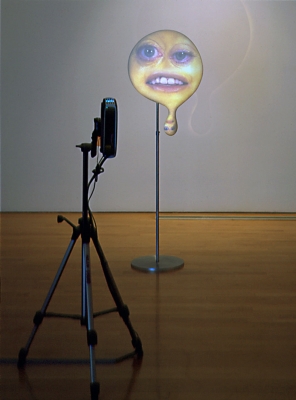Margo Leavin Gallery, Los Angeles, CA
Apr. 24 - May. 27, 2004



In 2003, after reading about Japanese children feeding pets on the internet, Oursler grew increasingly interested in the way technology serves a surrogate friend. How did this empathetic bond develop between machines and humans, and how could it potentially evolve in a digital space?
Using new image-processing technology, which at the time allowed for sophisticated photographic, high- resolution manipulation, such as stretching, bowing, and twisting, Oursler began to shape a cast of digital pets or companions. Based on the notion of a caricature, this series references a wide variety of sources, from Harvey Ball's 1969 smiley face, to the fertility goddess Venus of Wilendorff and Japanese manga. The often overtly humorous, somewhat grotesque characters attempt to seduce the viewer in various ways. As Elaine King wrote, "[Oursler's] position on the exploratory edge was again evident... when he introduced a new brand of mutants. Stepping inside, viewers could imagine that the toons from Roger Rabbit had taken up residence in the gallery. Eight animated, phosphorescent, biomorphic creatures, varying in size and shape and displaying human characteristics like eyes, teeth, and mouths, occupied three rooms. Oursler used his own or friends' body parts for the projected human anatomy. At first glance, these bizarre alien beings might appear entertaining. However, one realizes all too soon that behind the blinking eyes, fluttering lashes, big beaming smiles, gleaming teeth, and puckering red lips, this pageant of projected images aglow with endearing virtual faces is not a funny affair."
For the texts, Oursler listened carefully to the way people speak to pets as well as to "pillow talk" and attempted to fuse the vulnerable, often embarrassing, private language of intimacy into the performances. Monosyllabic and moronic, the caricatures are often unsettling and provoke embarrassment in the viewer. The video editing programs of the time allowed Oursler to stretch and bend human features, exaggerating some and minimizing others, to suggest a cartoonish evolution which could only happen in a digital space. Michael Amy describes the technique: "Playing with the face in the way initiated by Picasso, and further explored by the Dadaists and the surrealists, is something Oursler engages with in a psychedelic series of heads of abstract biomorphic shape, with roots in surrealist practice seeking to reveal the workings of the subconscious. Unlike Picasso, however, Oursler has the nerve to give us faces without noses, and thus, lacking the point of gravity around which the other facial features are arranged. Oursler's nose-less faces are highly disturbing- evoking, at times, disease, accident, mutilation, altered states (including noses melted off by too much heroin or cocaine intake), and aliens (Ello and Rubio, both from 2003)."
